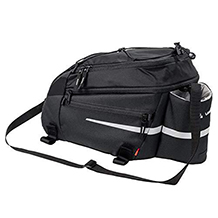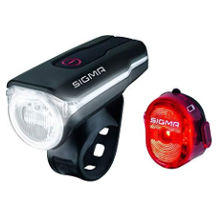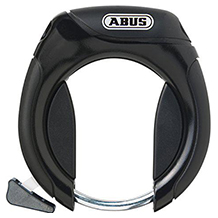Bike pannier bag purchasing advice: how to choose the right product
- What you need to know
- Bike bags add storage space to the bike – this is especially practical for commuters.
- On a bicycle trip front and rear panniers are recommended.
- A lowrider is usually required to attach front panniers.
- On bicycles without a rack can be attached frame and saddlebags
Practical bike bags for professionals and touring cyclists
Riding a bike is a healthy and environmentally friendly way to get around. But whether in everyday life or on a bike tour, the bikes have a clear disadvantage compared to cars: They do not have storage space. Especially bicycle commuters therefore make do with backpacks and shoulder bags. While the former only make for a sweaty back in the summer, the latter can even cause a dangerous shift in the center of gravity. The safer solution is to attach a bicycle bag to the means of transport itself. If you are planning a longer tour, you can’t avoid one, after all, you can hardly cycle comfortably with a large backpack.
Even if it doesn’t look like it at first glance, a bicycle offers a surprising amount of space for luggage. A relatively common sight are bags located on the left and right side of the rear wheel. They fit on just about any city or trekking bike, but not on road bikes or mountain bikes, as these do not have a rack to which the bag could be attached. There are other solutions for this, such as frame or saddle bags. If you want to carry a lot of luggage on your bike, you can attach a so-called “lowrider” to the front wheel.
What are the bike bags?
The range of bicycle bags is as diverse as the cyclists themselves. It ranges from small handlebar bags that hold little more than a wallet, to rear panniers with multiple compartments that can fit everything necessary for a bike tour lasting several weeks.
Rear wheel bag
These bags are often called luggage carrier bags, because they are attached to it. Just as common is the designation rear panniers, because the bags can be mounted either on the right or left, or on both sides of the rear wheel. Some versions are designeddirectly as a double bag. The rear bag offers plenty of storage space and is also suitable for bulky or heavy loads. A single bag often has a volume of about 20 liters. For a long tour with a lot of luggage two side pockets are recommended.
Because the rear pannier can be easily attached to the luggage rack, it is often the first choice when it comes to bicycle bags. Due to its position on the rear wheel, it also has hardly any influence on the handling. Many commuters in urban transport rely on such bags. Here, it’s worth paying attention to features like a padded laptop compartment.
Front wheel bag
Front panniers are often seen on bicycle travelers who go on very long and far tours. The bags are located on the front wheel at the height of the fork. Some versions can be attached to the fork with the help of Velcro, but usually a so-called lowrideris required. This is a special carrier for the front wheel, to which the bags are attached. For such a lowrider can be mounted, the bicycle fork must have a thread on each side at half height.
So that the steering behavior is not negatively affected, only light and voluminous equipment should be stowed in the front wheel bags, such as a sleeping bag or a pillow. Front panniers are smaller than rear panniers and have a capacity between 10 and 15 liters.
Luggage carrier bag
Although the rear pannier is also often referred to as a carrier bag, the “true” carrier bag is located on it and not to the side of it. So it is a bag that is attached to the luggage carrier with the help of various closure techniques. Compared to the rear bag, it has a fairly small capacity of 10-20 liters. The carrier bag can be combined well with two rear panniers to get the maximum storage space out.
Frame bag
There is also room for luggage on the bike frame. Frame bags are attached directly there with straps. Since the weight is placed in the center , this form of creating storage space hardly affects the handling. For this reason, frame bags are particularly suitable for stowing heavy, compact items. It is always important to remember not to overload the bag. After all, a bulging frame bag would be a hindrance when pedaling. In addition, frame bags cannot be sensibly attached to many bicycles with a low entry.
Saddlebag
Saddlebags are attached to the seat tube and the saddle itself. They come in different sizes, so that the smallest sit directly under the saddle, while larger models protrude far back. The capacity of a saddlebag can range from 0.3 to 8.0 liters. In small versions find only patch kit and multitool space, in larger bikepacking saddlebags fit even a sleeping pad or a tent.
Handlebar bag
The handlebar bag is probably the smallest bicycle bag. It is attached to the front of the handlebar using various systems and thus offers the advantage of providing quick access to important items at any time, such as the cell phone or wallet. But even in the case of the handlebar bag, there are bikepacking versions that are sometimes significantly larger and even have a capacity of up to ten liters.
Important selection criteria when buying a bike bag
The bike bag of your choice must be large enough to accommodate all the items you need. Bicycle bags are usually at least water repellent. Pay attention to whether the bag is designated as waterproof, if this criterion is crucial for you. Since the bags can hide reflectors on the bike, they should have them themselves for road safety reasons.
Storage space and dimensions
A bike bag basically has only one task: to provide enough storage space. How much space is needed depends on individual needs. If you commute to work by bike, you may only need a single rear pannier to stow a file folder, lunch box or laptop. Mountain bikers keep a cell phone or repair kit in a handlebar bag. It is important that a bicycle bag is designed to be as compact as possible, so as not to have too negative an impact on the driving experience. The dimensions of the bag should also be sufficiently narrow so that the bike is not too wide. A bike bag should also be reasonably light so that the total weight of bike and luggage is not too high.
| Type of bag | Approximate capacity |
| Single rear bag | 20,0-40,0 l |
| Single front wheel bag | 10,0-15,0 l |
| Luggage carrier bag | 10,0-20,0 l |
| Frame bag | 0,3-10,0 l |
| Saddlebag | 0,3-10,0 l |
| Handlebar bag | 0,3-10,0 l |
Material and waterproof
PVC is often used in bags designed for durability, including bicycle bags. Also common are the tough synthetic fibers nylon and Cordura. The surfaces are coated on one or both sides. This water repellent impregnation gives them the typical canvas look. If you are transporting sensitive cargo, you should opt for a hard plastic case.
Even if the material is robust and waterproof, this does not necessarily apply to the whole bag. Most manufacturers do not call their bags waterproof, but water repellent. This means that water beads off the surface. In normal rainfall, the contents remain dry. However, from a certain strength of rain, the moisture penetrates inside. The weak point are the seams. If they are only glued or sewn, they are not waterproof. A waterproof bike bag has welded seams and waterproof closures. Additional protection is provided by a rain cover, which covers the closures but again.
Safety aspects
A safety shortcoming of many bike bags is that they cover reflectors on the bike. This is especially true for rear panniers. Therefore, make sure that the bag itself has features that provide better visibility. This includes, for example, reflective yarn that lights up as soon as it is hit by car headlights, for example. Especially common are reflectors, which are placed on the sides of the bags. If such safety equipment is missing, be sure to upgrade yourself and attach reflectors to the bag.
How to attach bicycle bags?
If you are planning a ride with luggage, the bike bag must be properly secured beforehand. Here, there are different fastening systems from model to model. For example, smaller saddle or frame bags often have Velcro fasteners. With increasing weight, however, Velcro fasteners reach their limits.
Most bicycle bags are attached with the help of so-called click systems. This involves screwing a bracket to the bike and hooking the bag. It hooks in and sits tight. Some manufacturers additionally rely on Velcro fasteners. So that the bags do not turn away from the bike in curves, some bike bags have a clamp.
When attaching a bag to the bike, make sure that it fits as tightly as possible to the bike and that there is as little clearance as possible within the bracket. When driving over uneven paths, the bag should wobble only a little. If heavy load is too loose, it puts additional stress on the seams and fasteners. In principle, the load in the bag should also be immovable.
Properly pack bicycle bags
A good organization of the luggage bags is indispensable for a long bike trip. The most important point of reference when packing is the symmetry of the bike, which must be respected at all costs. Heavy items should always be stowed at the bottom of the bags and towards the center of the wheel if possible. Outer bags on both sides must weigh the same, otherwise cycling becomes a strenuous balancing act. The bike rides safest and most balanced with a weight distribution of about one-third in front and two-thirds in back. So if you have a lot of luggage, it’s best to divide it into front and rear panniers. The ideal situation for steering behavior is when the center of gravity of the weight is at the height of the wheel axles. This also ensures the best safety in curves and braking.
Each bicycle has a total allowable weight, which is the weight of the bicycle, the rider and the luggage. This weight should not be exceeded. It can usually be found in the instructions for use. Also luggage racks have a maximum load, which is usually between 20 and 40 kilograms.
The motto “less is more” is especially true for bike travelers; after all, every gram makes a difference on a bike. Front and rear panniers can store compact items such as sleeping bags, sleeping mats or even gas stoves. Everything that is often used, such as the rain jacket or cell phone, should be stowed in the upper part of bags or immediately in a frame or handlebar bag. Furthermore, it makes sense to keep things that are used together in the same bag. With the help of different colored bags or pouches, the togetherness can be visually signaled.


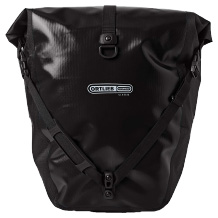
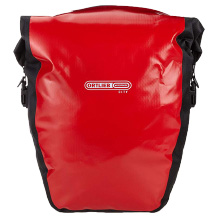
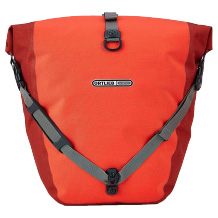

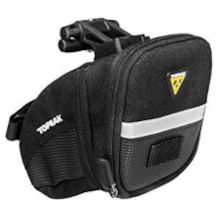
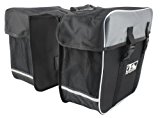
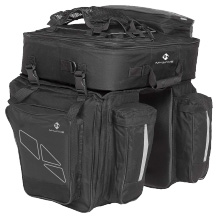
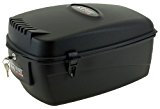
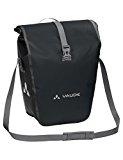
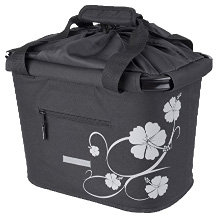
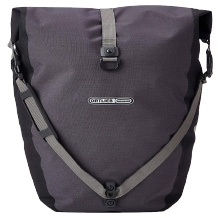
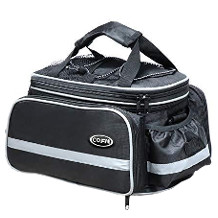

 1,900 reviews
1,900 reviews





